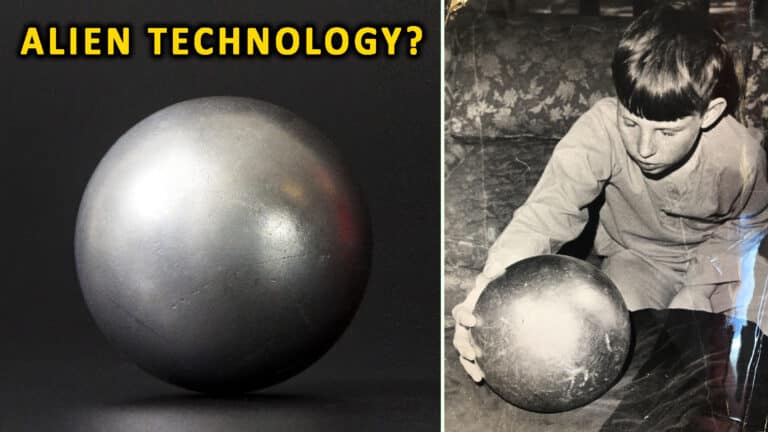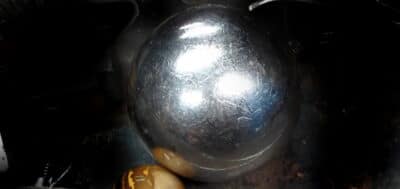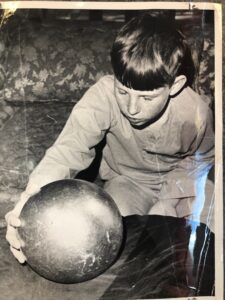Nowadays, we are so used to scientific and technological development that almost nothing can surprise us anymore.
However, there are a large number of strange artifacts that science hasn’t been able to find a reasonable explanation for, either due to the way they work or even their very own existence:
Books with strange codes, unexplained maps, stones carved with unusual shapes, ancient figures that depict strange things, and… the case of the Betz sphere, a mysterious metallic sphere accidentally found by an American family during the 1970s that had the ability to move on its own…
At the time, the sphere caused a great media frenzy and came to be described by many as “alien technology.”
It all started in April 1974, when a family from the city of Jacksonville, Florida, found a strange spherical metallic object with an approximate weight of 20 pounds and dimensions somewhat smaller than those of a bowling ball.
The young medical student, Terry Mathew Betz, his mother, Gerri, and his father, Antoine, had been out to inspect the damage caused to their property by a fire that engulfed nearly 88 acres of swampy forest on Fort George Island, located east of Jacksonville.
During their inspection, the family came across an interesting metallic sphere that was surprisingly undamaged.
Indeed, despite the fact that the sphere was in an area that was devastated by fire, it showed no signs of burns or scratches, quite the opposite:
The sphere featured a perfectly polished, shiny look.
At first, Terry and his parents suspected that it might be a cannonball from the time of Spanish colonizers in the region.
However, they discarded this hypothesis, mainly due to the perfectly preserved appearance of the object.
Then they thought that it could be an object owned by the government, specifically NASA.
Or perhaps it could even be a part of a Soviet satellite.
It’s important to remember that in 1974, the Cold War between the United States and the former Soviet Union was at its peak, so Americans were constantly worried about the possibility of a Soviet attack.
For a moment, the family also considered the idea that the object itself was the cause of the fire, but they never found any evidence of this.
What could this strange metallic sphere be?
Without an answer and after some consideration, the family decided to take the sphere home.
The sphere found a home in the room of the young Terry Betz and stayed there without causing any trouble until something very curious happened, precisely on April 26.
That day, Terry was with his friend Theresa Fraser, practicing his guitar as usual. Suddenly, the two young people started to observe something that seemed undoubtedly very strange:
The sphere began to “vibrate” and emit a pulsating sound, apparently in response to the sound emitted by the guitar. After a few minutes, they noticed that the sphere was also emitting what seemed to be a kind of resonance that was inaudible to the human ear. They only managed to figure this out due to the behavior of the family dog.
In the words of Gerri Betz, Terry’s mother:
“There must be some high-frequency waves from it.”
“When we put our poodle beside the ball, she whimpers and puts her paws over her ears.”
A few days after this incident, the Betz family began to notice other strange occurrences also related to the sphere.
The family discovered that by placing the sphere on the ground and pushing it slightly, it could change its trajectory at will and then return to the starting point.
In fact, the Betz family even claimed that on one occasion, the sphere managed to stay in motion for about 12 minutes before it finally stopped.
As Terry had a rather curious personality and was also motivated by the strange events related to the metallic sphere, the young man began to carry out a series of home experiments to try to find out what it was all about.
Terry hit the sphere with a hammer to see what happened.
This caused the sphere to ring like a bell.
After that, Terry took the sphere and shook it vigorously, then placed it on the ground.
To Terry’s surprise, the sphere seemed to come to life and roll around the room as if trying to get away from the young man.
Furthermore, the object seemed to emit a low-frequency vibration, as if it had some kind of motor inside.
On the other hand, if he placed the sphere on a glass table, it would move toward the edge of the table and then move away from it and toward the center of the table.
Even more surprising was the fact that if the glass surface was tilted to one side, the sphere would move in the opposite direction, defying the law of gravity!
Another intriguing factor was that the sphere had some kind of small triangular spot or pattern, which apparently represented the magnetic region of the orb.
While running all these tests, the Betz family realized that the sphere also seemed sensitive to weather conditions, specifically sunlight.
They observed that the sphere’s abilities became more intense on sunny days, something that didn’t happen on cloudy days.
Did the sphere use sunlight as a source of energy?
This conjecture is strange, considering that in the 1970s, solar energy was not commonly used…
This strange ability of the sphere to move by itself ended up worrying the Betz to the point that they kept the sphere in a closed sack overnight.
Just as a precaution in case the sphere tried to escape…
The Betz family were so amazed at the sphere’s capabilities that they began showing it off to friends and family.
As expected, the news spread quickly thanks to word of mouth, and more and more people became interested in learning about the mysterious sphere.
At the suggestion of friends and family, the Betz finally decided to go public with their artifact, perhaps to see if the authorities could help them discover what the object was.
Many newspapers showed interest in the story, with the earliest article pertaining to the Betz sphere being in Jacksonville’s daily newspaper, The Florida Times-Union, published on April 11, 1974. The article contained the following description of the sphere by Mrs. Betz:
“It would stop and then begin to return toward the person who rolled it only to stop a short distance from the person and sort of vibrate, making knocking noises as if hitting itself against the floor. Also, there was a slight noise inside, like the sound made when you shake a defunct light bulb, and the broken filament rattles a bit. It is a very tiny sound but definitely there.”
The local Jacksonville newspaper also became interested in the story and sent an experienced photographer to the scene, Lou Egner, to see what information he could get.
Egner was a very skeptical person, but he respectfully accepted the job.
When the photographer arrived at the Betz home, Gerri greeted him eagerly and quickly showed him the sphere.
Egner described the following scene in the April 12 daily edition of The Palm Beach Post in the following words:
“I’m leery of this kind of thing. When I got there, Mrs. Betz said, ‘You won’t believe it if you don’t see it.’ She told me to put in on the floor and give it a push. It rolled a ways and stopped. So what? She said ‘just wait a minute.’ It turned by itself and rolled to the right about four feet. It stopped. Then it turned again and rolled to the left about eight feet, made a big arc and came back right to my feet.””
Egner was very surprised by the abilities of the metallic sphere. He examined it carefully, but like the Betz family, he couldn’t find the source of its mysterious behavior.
Over the course of five days, the Betz case broke out in various media internationally.
Within a few days, reporters from prestigious publications, including the New York Times, began arriving from different parts of the world.
But not only the press but also the scientific and military communities showed interest in the strange phenomenon.
Even representatives of the United States Army and NASA contacted the Betz family, as well as various associations of UFO researchers.
Many visitors came skeptical about witnessing the phenomenon, but practically all left surprised to see what the sphere could do.
Even the United States Navy went so far as to admit on TV that they had no idea where that object might come from.
At the same time, they declared that the sphere was not the property of the US government.
In the midst of all this commotion, renowned astronomer Dr. J. Allen Hynek requested that the Betz family send the sphere to his office at Northwestern University in Chicago for further inspection.
However, the Betzes refused, fearing the sphere would be lost.
So the strange artifact remained in the Betz house, until some new events started to happen.
Suddenly, the family began to hear organ music in the middle of the night, even though they had never had such an instrument in their home…
On top of that, the doors opened and closed on their own at any hour of the day or night.
It was then that the family agreed to leave the sphere with scientists at the Jacksonville Naval Air Station.
Experts from the United States Navy put the sphere through a series of tests, but their initial efforts proved futile.
Their machines were unable to penetrate the object.
Chris Berninger, the Navy spokesman, said:
“Our first attempts at X-rays lead us nowhere. We will use a more powerful machine on the sphere and we will also run a spectrograph to determine what metal it is made of.”
Eventually, the scientists were able to determine several characteristics of the sphere, including its exact diameter, its weight, and the thickness of its coating.
This was half an inch thick yet could withstand a pressure of 120,000 pounds per square inch.
This coating was some kind of stainless steel that had a magnetic alloy and was resistant to corrosion.
The X-ray equipment also revealed two round objects made of a material of unusual density inside the sphere.
They also observed that the sphere had four different magnetic poles, two positive and two negative, and that they were concentric.
But they also came to the conclusion that the object was not radioactive or explosive, so they requested permission to break up the sphere and examine it in more detail.
However, Gerri Betz didn’t accept this, and the Navy ended up returning the object to its owners.
However, many questions remained unanswered.
What were those two round objects inside the sphere?
Was the Betz family in possession of genuine “alien technology“?
Perhaps some kind of “alien listening device“, as many have termed it?
In July 1974, Dr. Carl Willson, a representative of the research company Omega Minus One Institute, examined the sphere for several hours and discovered that the magnetic field around it emitted radio waves.
Willson further said that the shell of the sphere contained an unknown element that made it slightly different from steel.
Apparently, Mr. Willson also witnessed the capabilities of the sphere, going so far as to say that it defied the known laws of physics.
The results of the Omega Minus One Institute’s investigation into the origin of the sphere were similar to those of the Navy, so the mystery around the sphere remained.
That same year, some members of APRO managed to convince the Betz family to bring the sphere to the UFO Congress, since it could be proof of the existence of extraterrestrial life.
In addition, there was a $50,000 prize offered by the National Enquirer magazine for anyone who could prove the existence of aliens.
In the event, the mysterious metallic ball became the center of attention again, being subjected to various tests, always in the custody of Terry Betz.
The Enquirer magazine was commissioned to assemble a high-level panel made up of various notable experts such as:
-
Dr. J. Allen Hynek
-
Dr. James Albert Harder
-
Dr. R. Leo Sprinkle
-
Biologist Frank B. Salisbury
-
and Professor of Philosophy, Dr. Robert F. Creegan
In addition, the panel also included other high-level members, such as a former Supreme Court Justice, a former United States Attorney General, and a former New York Court of Appeals Judge.
And of course, representatives of various UFO research organizations such as APRO, MUFON, and NICAP also participated in the tests.
After a whole series of tests, the experts concluded that, despite everything that was already known about the sphere’s capabilities, the device functioned as an audio transmitter.
Although they were unable to determine the origin of the object, they still ruled out that it was of extraterrestrial origin.
Given this, the Enquirer denied the Betz family any chance of winning the $50,000 prize.
At the end of the event, J. Allen Hynek said that the object was likely man-made, while he also admitted having no idea what it was or where it came from.
However, the sphere caught the attention of a high-level panel member, Dr. James Albert Harder, who would later carry out some studies on the artifact.
The Betzes allowed Harder to analyze it, and the results were both intriguing and terrifying.
On August 24, 1974, Dr. James Albert Harder, after having carefully examined the sphere, made an announcement at the International Congress of Ufology in Chicago that left all attendees astonished.
According to a report based on X-ray studies, the two inner circles of the sphere were made of an element much heavier than any known material on Earth.
The heaviest element produced in any atomic reactor has an atomic number of 105.
While the heaviest element that occurs naturally on Earth is uranium, with an atomic number of 92.
However, the atomic number of the element inside the Betz sphere was 140.
Dr. James Albert Harder stated:
“If someone tried to split the sphere, it could explode like an atomic bomb.”
The Betz family expressed concern, but they kept the sphere.
After those statements, skeptics began spreading stories intended to destroy the credibility of the Betz family.
Exhausted, the family decided to move far away, and nothing more was heard from them until December 1987, when Antoine Betz passed away at the age of 67.
Skeptics claimed the metal ball was nothing more than a Jacksonville Equipment Supply company check valve.
Even the president of the company, Robert Edwards, gave statements in this regard:
“I’m not saying that this thing didn’t come from outer space because I’ve never seen it,”
“All I’m saying is that the physical description of it matches exactly the type of ball we have in stock.”
Also, sculptor James Durling-Jonesque claimed to have lost an orb that fell from his Volkswagen van while driving through Jacksonville, in 1971.
Durling-Jones claimed to have gotten some industrial valve balls from a friend who got them illegally.
However, the experts who examined the orb did not observe any marks of the welding that industrial valves usually have, which casts doubt on these last two statements.
After this, the public’s curiosity quickly waned.
Following this bizarre series of events, numerous spheres similar to the Betz sphere have appeared around the planet over the years.
However, none have managed to capture the world’s attention as much as the Betz sphere did in its time.
Still, the mystery persists among believers.
Where is the Betz sphere now?
Was it confiscated by the United States government?
Why did the Betz family decide to hide like that?
Would Dr. Harder’s statements have something to do with this?



